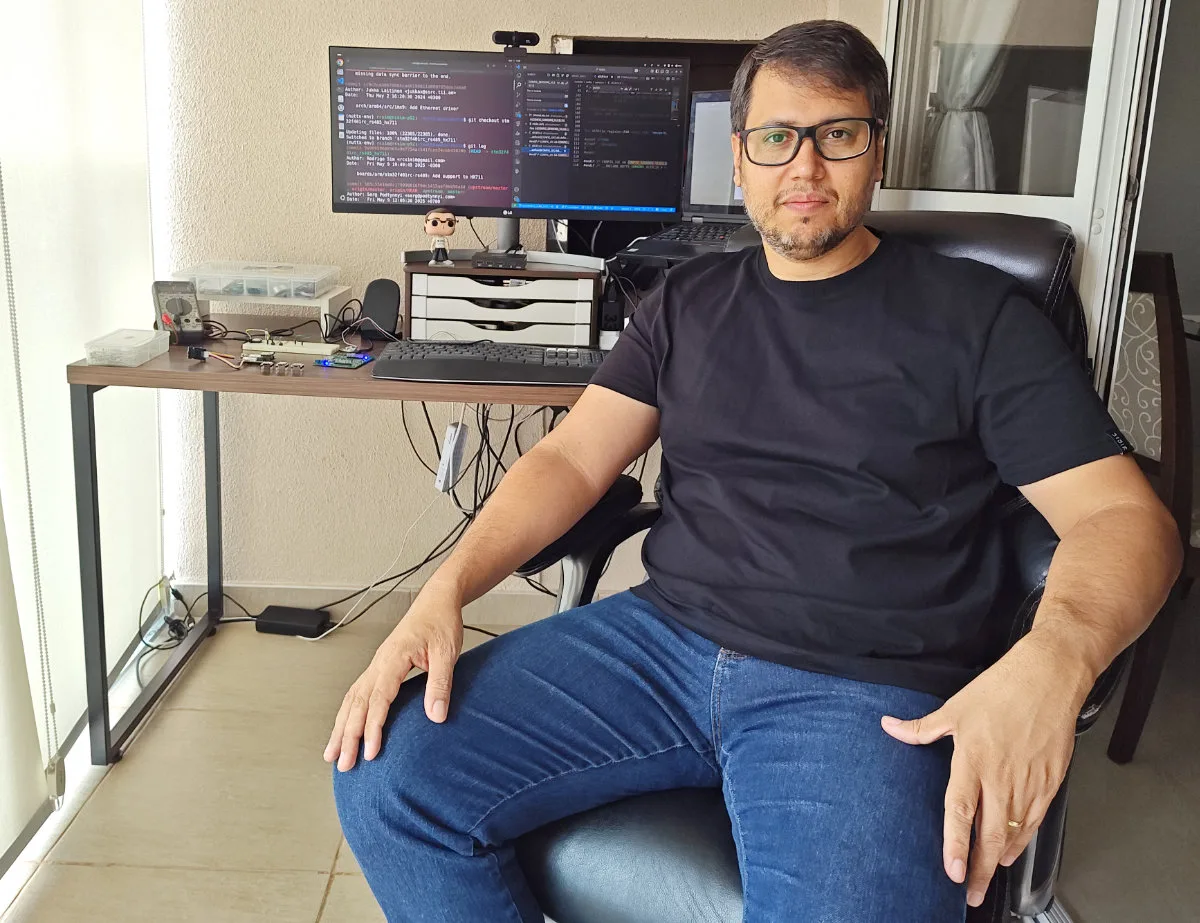Rodrigo Sim is a busy Tech Lead and Senior Software Engineer at Motorola with a passion for supporting the open-source embedded community. In his spare time, he puts in the hours to make NuttX, a free and open-source real-time operating system (RTOS) even better by bringing it to as many development boards as possible. “NuttX has an incredible community that is always eager to help. Since Gregory Nutt started NuttX some time ago, it has grown through the collaboration of many passionate people. I can tell you from my own experience that contributing to an open-source project is very rewarding.”
A computer aficionado since high school, his first experience was through a digital electronics class that was offered: “I even had the chance to work with a Z80 kit — that was the true beginning of my career.” His journey took a turn towards telecom, initially working as an equipment technician for a satellite communications company, and later joining Motorola. “I have spent most of my career at this company, working across many different roles and teams: from hardware debugging in manufacturing, to test engineering, product engineering, and today, more focused on software engineering.

“It was during my journey at Motorola that I first encountered NuttX. Motorola launched a product line called Moto Mods, which allowed users to add hardware extensions to Motorola devices. The Moto Mods platform used a fork of NuttX. After a hackathon organized by Motorola, I had the opportunity to meet Mr. Alan Assis via LinkedIn, who has been my mentor ever since. His guidance has been invaluable not only to my development with NuttX but also to the entire NuttX community.”
Dipping your toes into embedded development was never as easy as it is today — nevertheless, it can seem a little challenging, so he believes that a combined approach focusing on both the theoretical and practical aspects might work best. “A great way to start would be by working on small practical projects, like reading different sensors and displaying the data on an LCD,” adds Rodrigo.

And regarding the beginnings of his own RTOS journey, he has a few words — and some advice for those also looking to start using one: “My first experience with an RTOS was using FreeRTOS, where I read data from an ADC, used PWM to play a song on a buzzer, and displayed the data on a screen.
“I believe that after engineers get a good understanding of bare-metal programming, specifically how to use basic peripherals and handle interrupts (ISRs), they can move to an RTOS like NuttX. It will help them scale their projects more easily, allowing the addition of new features and the integration of more complex peripherals.”
NuttX isn’t the only RTOS on the market, but for Rodrigo, his personal investment aside, there’s still good reason why it should be your pick. “As a Linux user since very early in my career, the first thing that caught my attention with NuttX was its POSIX-compatible API. However, there are many other reasons why NuttX has become my preferred RTOS today.
“It is highly modular, offers very advanced features out of the box, can run on microcontrollers ranging from 8-bit to 64-bit, is well-supported by many different chipset vendors, and has a very welcoming and easygoing community,” he notes, adding that trying different options and figuring out what works for you is, at the end of the day, still the best approach.
We’ve encountered Rodrigo’s work during our time with Seeed Studio’s XIAO RA4M1 development system as he was the person behind the board’s NuttX port. Rodrigo goes on to detail the experience: “The initial chipset support for the RA4M1 was added by Leonardo Afonso (FAE at Renesas), and I later added support for the Seeed Studio RA4M1 board.
“Since my first contribution to NuttX, I have been trying to stay active by contributing regularly and helping to add support for new boards so that more people can use it. Specifically for Seeed Studio boards, I’ve added support for the RP2040, RP2350, RA4M1, ESP32-S3, and recently submitted support for the ESP32-C3. I’m currently working on the ESP32-C6.

“Each board came with its own challenges, and overcoming them, while helping NuttX continue to grow, has definitely been my main motivation for these contributions.”
Despite his work on popularizing the platform and making it more accessible, Rodrigo feels that future popularity of the platform depends on the onboarding experience: “I think the growth of NuttX depends on a combination of factors. Of course, adding support for new chipsets, boards, and sensors is an important part of it, but providing an easier way for newcomers to try it out is also very important.
“Today, not everyone wants to read through documentation, even though NuttX has very good documentation available, so creating blog posts, publishing videos on the official NuttX YouTube channel, and promoting the NuttX Workshop that we host once a year are other great ways to help spread awareness and adoption.”
With AI being the thing in the tech world, we just had to pop a question regarding its use and its effect on the embedded scene. Rodrigo’s take is generally optimistic: “Talking about the future is always tricky, but I try to maintain a positive view of all the AI buzz. It may help improve productivity, but I think we need to use it very carefully and not simply copy and paste from AI tools without fully understanding what the code is doing.” Despite the words of caution, he does stress that outright ignoring these new options would be dangerous — a balance of personal knowledge and effective AI use is crucial for aspiring developers.
At the end of the day, he’d love to see not only more people using NuttX, but also the surrounding community. “Give NuttX a try, and come collaborate and contribute with us!” Rodrigo concludes.


